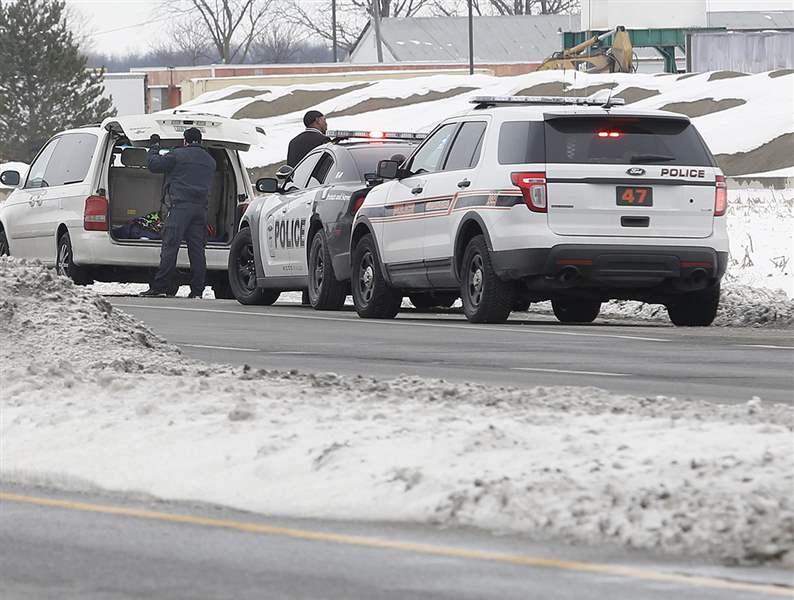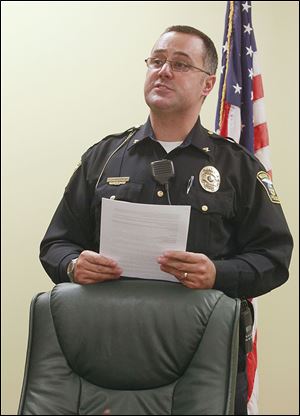
A BLADE INVESTIGATION
Welcome to Woodville: You’re busted
Village’s volume of citations reinforces speed-trap reputation
2/8/2015
Woodville police make a stop on U.S. 20 on the east side of the village. The village issued 1,173 speeding tickets in 2014.
THE BLADE/AMY E. VOIGT
Buy This Image

Woodville police make a stop on U.S. 20 on the east side of the village. The village issued 1,173 speeding tickets in 2014.
WOODVILLE, Ohio — Woodville police officers write more speeding tickets on average than their counterparts in multiple comparable area communities, according to an investigation by The Blade.
Those tickets and others handed out for traffic violations make up a bigger share of revenue into Woodville’s treasury each year than the ticket revenue of other area villages and cities surveyed.
The Sandusky County village, which is bisected by a busy U.S. 20, has long had a reputation as a speed trap to be avoided. James Tramel of Ortonville, Mich., says he drives out of his way just to avoid the village and save his wallet.
While traveling last summer to Marietta, Ohio, Mr. Tramel used the heavily trafficked U.S. 20 through the village and he got caught: 15 mph over the 25 mph limit.
In a place with a restaurant called the Speedtrap Diner & Dairy at 310 E. Main St., residents and out-of-towners alike know to watch their speed because motorists with a heavy foot are stopped.
A November traffic stop for speeding turned violent when a Woodville police K-9 officer shot and seriously wounded a chocolate Labrador retriever named Moses that approached the scene. In that case, the driver received a warning — something Police Chief Roy Whitehead said outnumbers actual speeding citations. But that traffic stop resulted in widespread media attention and reminded people that Woodville officers patrol the town with radar guns on.
In Mr. Tramel’s case, a prosecutor allowed him to plead to a lesser traffic violation, avoiding points on his driver’s license but costing more in court fees, he said.
“It was a raw deal all the way,” he said.
Mr. Tramel, 67, now bypasses Woodville after he had to pay $169 in fines and court costs.
Village officials have created a “speed trap” that especially targets out-of-state motorists, he said.
Mr. Tramel is not alone.
The numbers
Woodville police issued 2,735 speeding tickets from 2012 through 2014, with the number of speeding tickets increasing each year — 598 in 2012, 964 in 2013, and 1,173 in 2014.
The village, with 2,101 residents, according to 2013 U.S. Census figures, the most recent available, has five full-time and six part-time police officers, which means they spend a lot of their time writing speeding tickets — 106 tickets per officer on average in 2014.

A Blade review of several northwest Ohio municipalities found some nearby, larger communities writing far fewer tickets than tiny Woodville.
Maumee, with 14,132 residents, has 41 police officers who handed out 617 speeding tickets in 2014. That’s an average of 15 each. Oregon police, who patrol the busy stretch of State Rt. 2 that connects to I-280, wrote 567 tickets last year. With 45 police officers, that averages 15 each in a city with a population of 20,239.
The village of Walbridge is about 14 miles from Woodville and slightly larger, with a population of 3,058. Officers there issued 82 speeding tickets in 2014, a small fraction of the 1,173 tickets written by Woodville police officers that year. The Walbridge Police Department employs five full-time and six part-time officers, who averaged about seven tickets per officer last year.
Bowling Green, with a population of 31,802, wrote 710 speeding tickets last year.
Chief’s explanation
Woodville Chief Whitehead said there are reasons his police officers write more tickets than officers in larger areas, and it’s not about cash for the community.
“Several thousand vehicles travel through our community every day — a community with four lanes of heavily traveled roadway and two school zones,” he said. “Our average citation is for 12 to 18 miles per hour over the posted limits. On average, 35 to 50 children cross U.S. 20 every day to go to and from school.”
A review of state traffic counts, however, shows that Woodville police recorded a large number of tickets despite a smaller amount of traffic. Thousands of vehicles drive through area communities at some of their busiest intersections, according to statistics collected by the Ohio Department of Transportation.
In an average day, Woodville at Pemberville Road and U.S. 20 has 12,950 vehicles; Maumee at U.S. 20 and Anthony Wayne Trail has 22,570 vehicles, and Oregon at State Route 2 and I-280 has 27,990 vehicles. Even with far less traffic than these larger cities, Woodville police issued more speeding tickets.
Woodville’s chief said officers 20 years ago would nail speeding motorists for the slightest infraction. That’s changed, he said.

Woodville Police Chief Roy Whitehead insists the Sandusky County village is not a speed trap.
“When I first started in 1994, the average [speed citation] was 5 mph over, and now the average is 12 to 18,” he said. “The first thing I tried to do when I became chief was to be community friendly, and writing tickets for 2 mph over or 6 mph over is not. And I can prove that we don’t treat out-of-towners or out-of-state people any differently. We try to be fair across the board.”
Chief Whitehead said the village does not set speed limits, and he would prefer a steadier limit in the village.
An Ohio Department of Transportation official said speed limits are determined by state law, depending on factors such as nearby development and housing. The agency works with municipalities to follow the statute and can conduct a variance study to alter those limits.
The Blade assessed 629 speeding tickets Woodville police issued in the first six months of 2014. A reporter was unable to determine the driver’s hometown in 303 cases because of the poor quality of the police department records and the faint writing on carbon copy paper.
Only two of the remaining 326 citations in which addresses were legible were for drivers from Woodville. These motorists were cited for traveling at 14 and 15 mph more than the limit.
A Blade review of speeding violations during that six-month period found that cited drivers exceeded posted limits by an average 15.76 mph.
But that doesn’t help the people who still get stopped for speeding.
Woodville police in August pulled over Grant Bremer, 20, of New Haven, Ind., and his two friends as they returned from Cedar Point. They were driving at about 2 a.m., he said.
The police officer ticketed Mr. Bremer for traveling 38 mph in a 25 mph zone. The officer questioned his out-of-state driver’s license as well, he said.
Matter of location
Woodville’s advantage in dinging drivers is its location.
In the heart of what was the Black Swamp, the terrain is flat as a plate, as locals like to say, and it’s easy to cruise along U.S. 20 at a decent clip. The 60 mph speed limit on the highway, which most drivers exceed, abruptly drops to 45 at the village limit, then 35, and then 25 through Woodville’s “central business district,” a couple of blocks of a dozen or more businesses. And drivers should be wary of the two 20 mph school zones.
Rossford is another northwest Ohio community known as a speed trap — chiefly for its nearly mile-long downtown stretch on State Rt. 65, which limits motorists to 25 mph.
In his nearly three decades as a police officer, Rossford Police Chief Glenn Goss said enforcement has changed.
“I see a change in enforcement going from traffic to more criminal investigations, and I don’t think Rossford is an island,” he said. “Fifteen or 20 years ago, it wouldn’t be uncommon for an officer to write three or four tickets a shift and not respond to a single criminal complaint.”
Rossford, which has about 6,500 people, handed out just 285 speeding tickets last year, up from 258 in 2013, and 110 in 2012.
With 13 full-time and two part-time officers, that averages out to 19 per officer in 2014.
For a city with two state routes, a U.S. route, and I-75, Chief Goss said those numbers are low.

“The message we are sending in Rossford is ‘be safe’ and not how much revenue can we make,” he said. “We don’t have a mayor’s court. We don’t keep court fines. In fact, the percentage that comes back to Rossford on any traffic citation is really minimal.”
Analyzing what communities make from traffic citations is tricky.
Communities with mayor’s courts can keep a lot more of the money than other places where the county and state each get a cut. Additionally, it depends whether the city uses its municipal code or state law to charge offenders.
Oregon Administrator Mike Beazley said the city loses money on its criminal justice system because of the costs of operating a municipal court.
“It’s a million dollar loser for us to be in the court business,” Mr. Beazley said.
Woodville’s traffic violations in 2012-14 netted it nearly 7.4 percent, 10.87 percent, and 14.25 percent of total village general fund revenues for those three years, respectively.
Traffic violation fines collected in Maumee, Oregon, and Rossford totaled less than 1 percent of total general fund revenues for each city in those same years.
Walbridge, which includes minor criminal violations in its fine revenues, averaged about 1 percent as well.
Perrysburg and Bowling Green officials said they could not provide a breakdown of traffic violation fines and speeding citation fines. Perrysburg Municipal Court Administrator Amy Rife said the figures were not listed as a line item in the budget.
Mayor’s courts
A March, 2013, Ohio law banned mayor’s courts in villages with fewer than 200 people, which was done chiefly to cut down on towns using speed-trap revenue to keep their books balanced.
The Ohio Supreme Court’s annual report on state mayor’s courts showed some communities just over the threshold still write a seemingly above-average number of tickets.
The Licking County village of Kirkersville, with just 525 people, issued 409 such tickets in 2013, the report said.
Woodville has four times the population, and it handed out 964 that same year.
In Lucas County, Berkey also has a mayor’s court. In Wood County, Haskins, North Baltimore, Northwood, Risingsun, Walbridge, and Wayne have mayor’s courts, according to the Ohio Supreme Court mayor’s court summary.
Walbridge Police Chief Kenneth Frost said the goal is public safety, and he does not consider revenue from tickets. Walbridge police primarily leave enforcement of I-280 to the Ohio Highway Patrol.
Traffic enforcement remains a priority for Walbridge officers, and they are given discretion whether to warn or cite, Chief Frost said.
“For the most part, people pretty much obey the speed limit when they come through town,” he said.
Richard Harman, who was Woodville mayor from 1984 to 1999 and was elected again in 2003, said the village had a mayor’s court up until 1999.
“I had mayor’s court for 20 years,” he said. “It ended with litigation in the state when they talked about DUIs and it was better off to go another way, so that’s what the next council did after I left in 1999.”
As for Woodville’s Speedtrap Diner, owner Samantha Haar said the business’ name came from a village moniker.
It serves as a clear warning to those passing through, Ms. Haar said, but she has no opinion on whether Woodville is actually a speed trap.
“Mainly, you might want to slow down when you come to Woodville,” Ms. Haar said.
Blade staff writer Ignazio Messina contributed to this report.
Contact Ryan Dunn at: rdunn@theblade.com, 419-724-6103, or on Twitter @RDunnBlade.